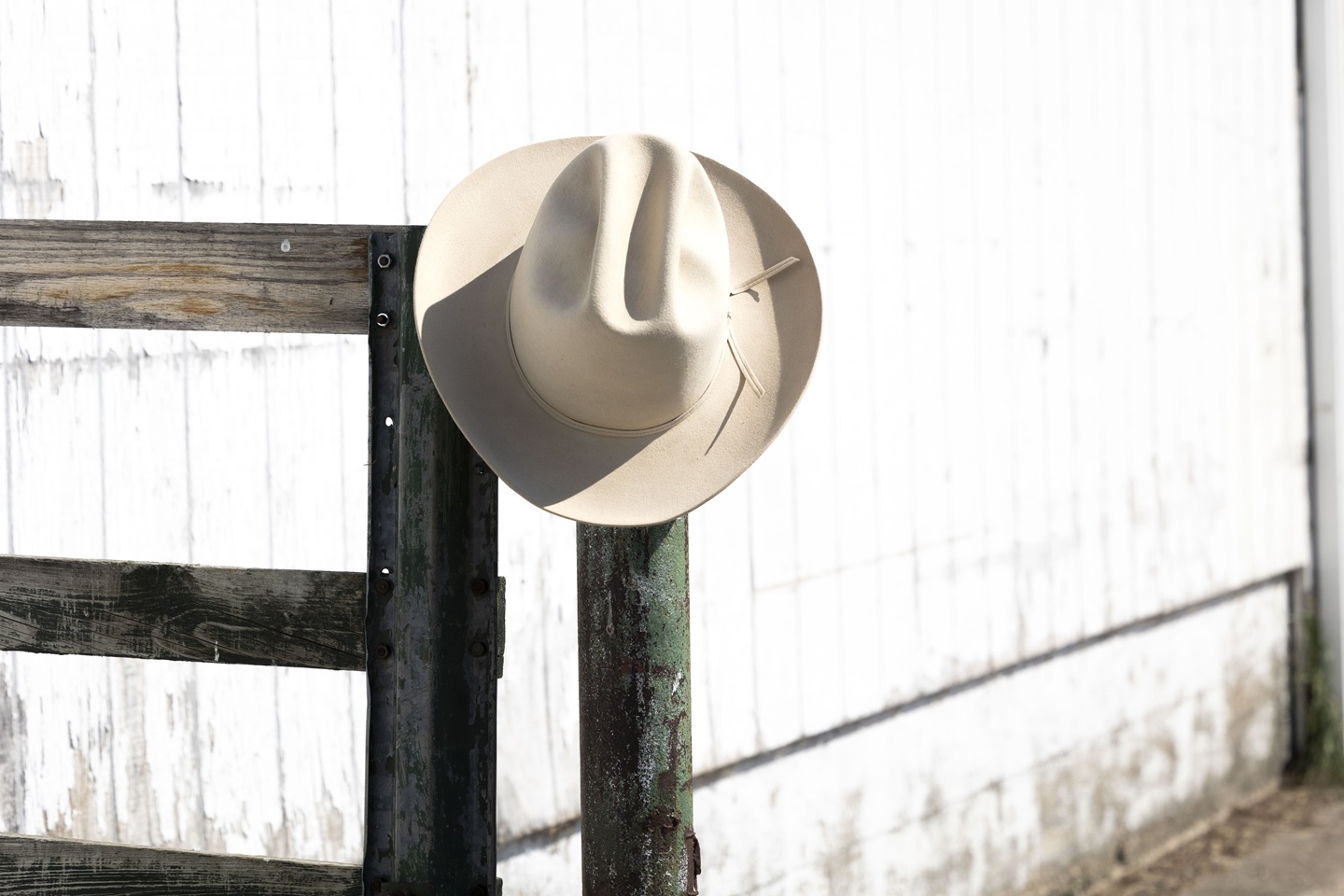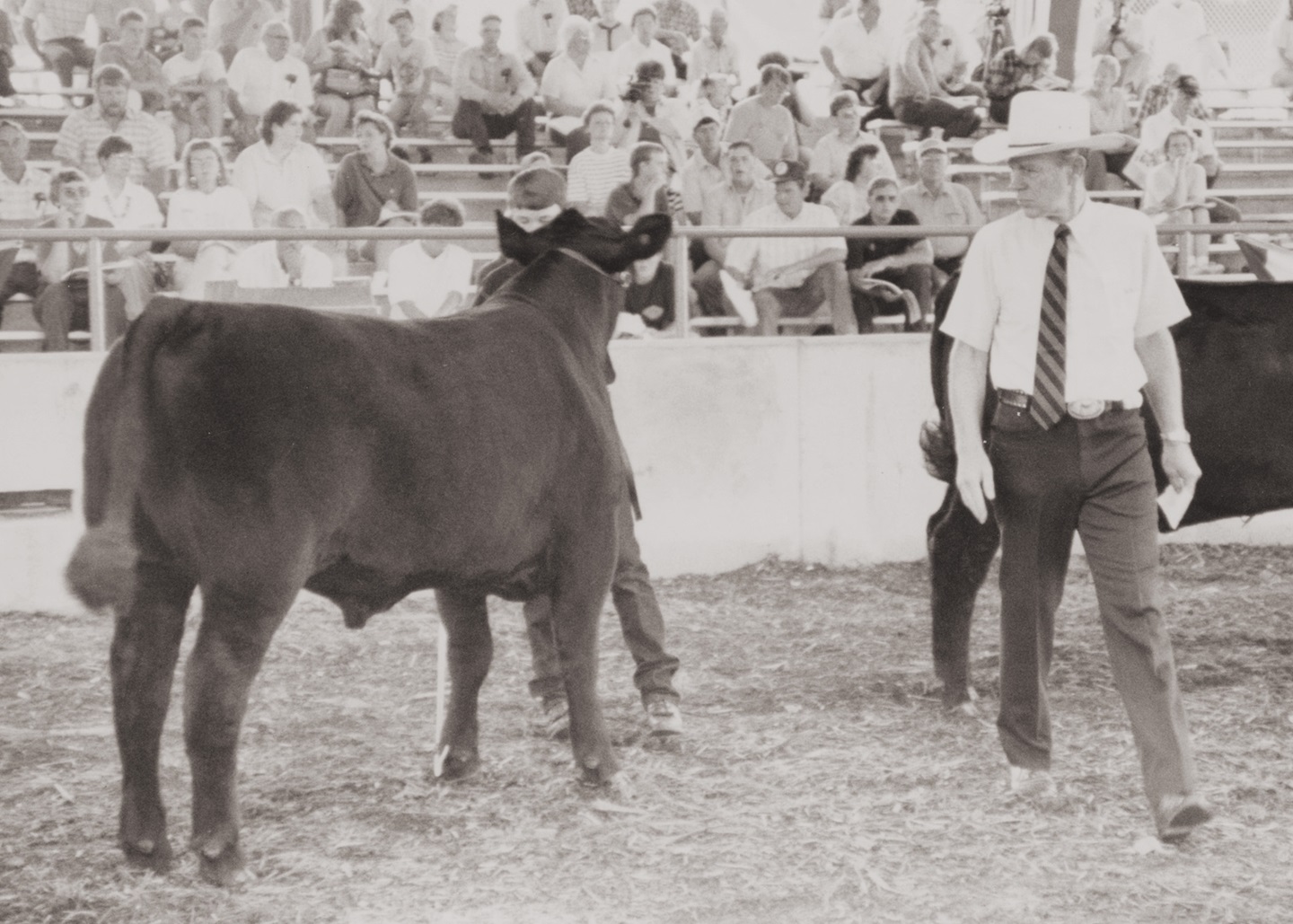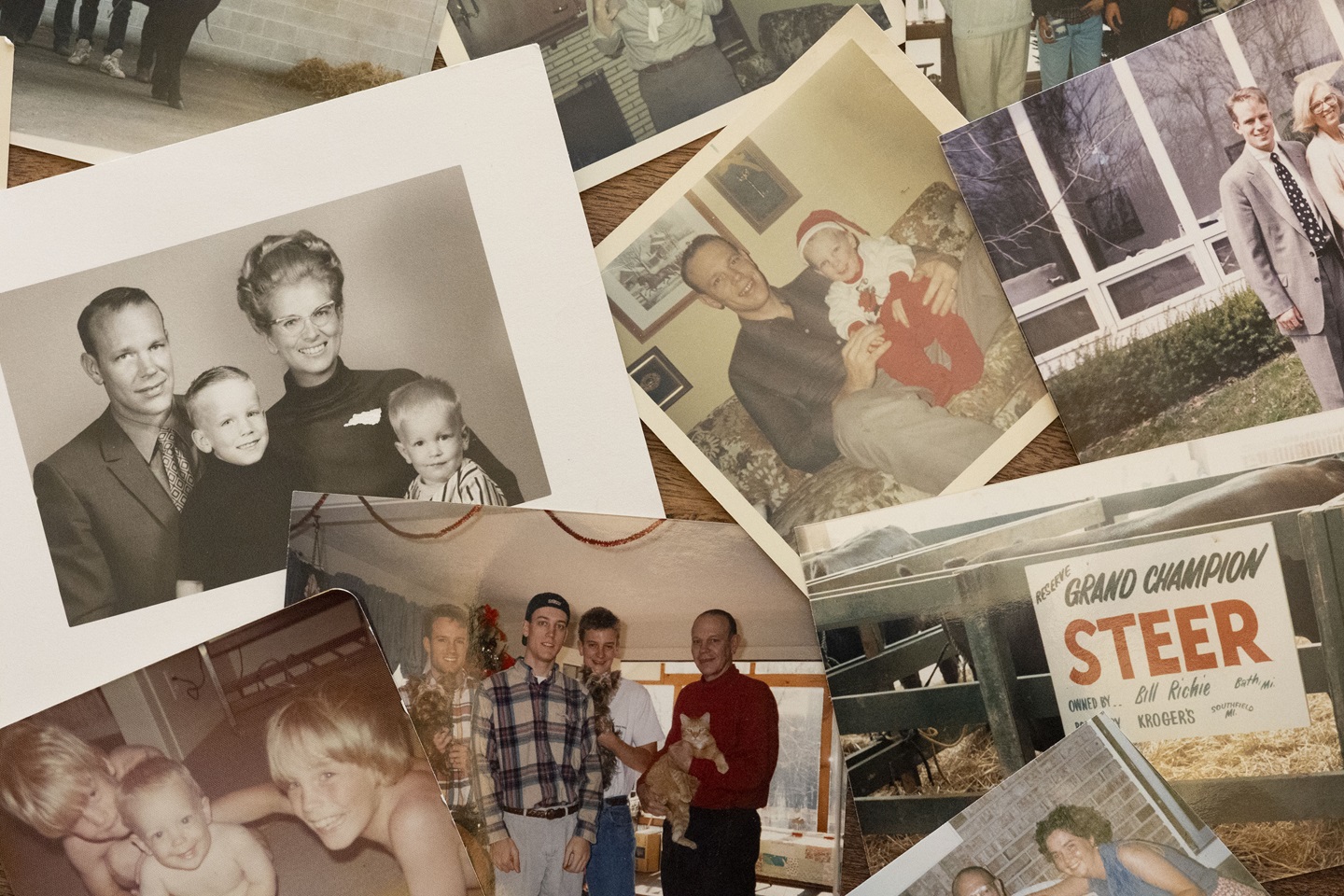The Lasting Legacy
Harlan Ritchie’s indelible impact on the U.S. beef industry.
May 16, 2025

A hush falls over the crowded stands. Those in their seats lean forward, bracing their elbows on their knees. Cowboy hats shade the glare of the lights as their eyes narrow in on the lineup before them. Eagerly, they await a decision that will influence the choices they’ll make on their operations in the next year.
In the arena, the lineup of cattle begin to fidget. The showmen on the halters work to keep their animals calm, splitting their attention between the restless bull at their side and the judge standing in the center of the ring, a look of contemplation on his brow.
In a decisive moment, the judge strides forward, hand raised, and slaps the back of the grand champion bull. But the roar of the crowd that should follow is muted by puzzlement.
The champion is certainly not the animal they’d expected to win.

The change maker
It’s the early 1960s, and Harlan Ritchie, Michigan State University (MSU) professor of animal science, is the judge making waves in the show ring.
Having the courage to walk out in front of thousands and thousands of people and slap an animal that you deem champion, that nobody else deems champion, requires tremendous courage. It is that courage that pushed our industry forward.” — Jason Rowntree, a current MSU professor of animal science
Ritchie would stand in an uncomfortable moment, in that criticism, time and time again. In fact, his long-time business partner and family friend, Ken Geuns, remembers many stories Ritchie told about people berating him as he left the ring or picking up his house phone to get an earful about his selections.
“Harlan was a man of action, and he was not about to buckle under somebody else’s pressure on something that he knew was right for the industry,” Geuns affirms.
At the time, the industry was producing cattle that matured at about 850 pounds (lb.) and produced carcasses that lacked muscle mass and were overly fat. The show ring was very demonstrative of that trend, but Ritchie was set on finding cattle with more growth and carcass value.
“[He knew] these decisions would make our industry better,” says Rowntree, who was mentored by Ritchie. “It would make our ranchers more profitable. It would generally make the sustainability and the resiliency of the United States beef industry stronger.”
While humans might be naturally averse to change, Ritchie’s selections in the show ring and his opinions on how to improve the beef industry were well respected and sought after. So much so, it’s one of his son’s most vivid memories of his father.
The communicator
Bill, the oldest of Ritchie’s three sons, often accompanied him to many of the shows. As a young, blonde, blue-eyed boy, Bill was just like any other child — in a hurry to get his hands on a stick of cotton candy as big as his head. But getting to the concession stand often required walking through the barns, which posed a problem in Bill’s mind. The pair could only make it a few steps at a time before Ritchie was pulled into another conversation.
“As a kid, I was always kind of frustrated by that,” Bill remembers. “As I got older, I started realizing people wanted to talk to my dad and that’s kind of cool. I started observing how he was with people.”
What Bill saw was unending patience, kindness and humility from the Iowa native.
Ritchie grew up the son of a northwest Iowa farmer and completed his undergraduate degree at Iowa State University in 1956 before moving to East Lansing, Mich., to become a lifelong Spartan.
Despite leaving Iowa in his early twenties, Ritchie held on to an endearing quality that has become a point of pride for the state and is fondly referred to as “Iowa Nice.”
“He just loved what he did, and it showed,” Bill says. “He was very approachable. I look back on those times as very representative of who my dad was as a father and, also, as a cattleman.”
The futurist
Whether at a show, conference or rushing across campus, most recall seeing Ritchie juggling his briefcase, his hat slightly askew, a pile of textbooks under his arm, a couple yellow legal pads of notes in hand and a pack of slides threatening to topple the professor. His mind was constantly in motion, and that meant never wanting to be out of arm’s reach of a pen or reference text.
“He looked to the future all the time. What do feed prices look like? What does a shrinking cow supply look like? How do we compete with poultry and pork?” Rowntree says. “He had a vision, and that — combined with his amazing knowledge of the industry, of genetics, of people — really allowed him to be that key leader.”
Ritchie didn’t leave his vision to happenstance, and spent decades scouting the United States for bulls that had the potential to change the type and kind of the industry.
In fact, the professor was so dedicated to his search, there are tall tales of Ritchie climbing fences in the middle of the night to get a look at a bull he’d driven hundreds of miles to see.
His search led him to Europe in the late ’60s and early ’70s, where he saw cattle that could make American cattle better. Ritchie brought the first Continental breeds to the United States, introducing them to the herd at the MSU research station in Lake City, where he was the faculty coordinator.
“He was on the forefront of hybrid vigor that brought these Continental cattle in. But simultaneously, he also worked to make Angus cattle more productive and growthy,” Rowntree points out.
Later in life, Ritchie would refer to the growth of the Angus breed in the United States during that time as “remarkable,” in his textbook Breeds of Beef Cattle.
“He really valued the Angus breed. That was clear to me growing up around him,” Bill says. “Just the way he talked about the breeders and the impact Angus cattle had on growth and development of the beef industry.”

The educator
In 1973 Ritchie, his wife, Lou, and their three boys moved to a piece of property eight miles north of campus and named the acreage Ventura Farm. The venture became another extension of not only Ritchie’s vision, but his ability to draw people together.
Geuns remembers being one of the many graduate students and colleagues who found themselves returning to the farm time and time again. Eventually, he never left, becoming Ritchie’s partner.
“I was initially so intimidated by him. How can a person of this stature and magnitude be interested in my opinion?” Geuns remembers. “But for some reason, he and I just nicked.”
The pair spent many Sundays sitting on a bale of hay in the barn, sharing a couple of cold beers and talking about what they wanted to accomplish in their operation. Managing those 20 or 30 head of cattle on Ventura Farm, Ritchie often said, made him a better educator.
“[He was] willing to share any of his experiences or opinions,” Geuns says. “It was important for him to scientifically justify something that he was suggesting to a producer to do.”
The student
Though he was an educator, Ritchie always considered himself a student of the industry and surrounded himself with others who felt the same.
“Anybody that wanted to be a part of the mission that was Michigan State, he cared about us enough to have us a part of it,” Rowntree says, adding he was floored as a young judging coach in 1998 to be invited to what had become a very prestigious annual gathering in the basement of Ritchie’s home — the Beef Bull Selection Party.
“There were all these icons [including Dave Hawkins and Larry Cotton] sitting around looking over EPDs (expected progeny differences) and talking about their travels and visiting all the bull studs,” Rowntree describes. “I was just in absolute awe.”
The bulls on the list the night Rowntree joined the party were part of the significant progress Ritchie saw during his five-decade career at Michigan State.
However, the professor always felt there was more to be done. Following his attendance at the 1988 National Beef Cattle Conference hosted at Oklahoma State University, Ritchie reflected once again on the future, writing:
“In 19 years, we have changed the growth of our cattle considerably, but the carcass, the product, really, is about the same as it was ... We need to stabilize frame size to fit market needs as well as to fit the environment ... We need some increase in muscle thickness without reducing overall productivity.”
Ritchie went on to encourage producers to cull hard and quickly to improve not only the muscle and frame, but fertility and feet of the day’s cattle.
“Ironically, he stayed late enough in his career that he had to pull back,” his son recalls. “[He had to] try to tell people that, ‘We are in a situation now where the cattle are getting too large.’”
It’s another reason why Ritchie is so admired. As influential as his research and insights were, he was always willing to reevaluate, to be honest about the state of the cow herd and its needs.
Ritchie never really retired and continued to write, research and consult well into his later years, a time when he also traded the view of the Ventura Farm barns for the sandy beaches of Florida in the colder months. But his love of cattle, his family and the great state of Michigan brought him and his second wife, Leah, back each summer. Ritchie passed away in April of 2016, closing the book in his lap for the final time.
“His legacy will always be a part of the American Angus industry and the beef industry, as a whole, as somebody who fought and pushed forward and put us in much better standing,” Rowntree says.
Topics: Association News , Member Center Featured News , Award winner , Industry News , News
Publication: Angus Journal


